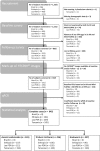Therapeutic efficacy of albendazole against soil-transmitted helminthiasis in children measured by five diagnostic methods
- PMID: 31369562
- PMCID: PMC6675043
- DOI: 10.1371/journal.pntd.0007471
Therapeutic efficacy of albendazole against soil-transmitted helminthiasis in children measured by five diagnostic methods
Abstract
Background: Preventive chemotherapy (PC) with benzimidazole drugs is the backbone of soil-transmitted helminth (STH) control programs. Over the past decade, drug coverage has increased and with it, the possibility of developing anthelmintic resistance. It is therefore of utmost importance to monitor drug efficacy. Currently, a variety of novel diagnostic methods are available, but it remains unclear whether they can be used to monitor drug efficacy. In this study, we compared the efficacy of albendazole (ALB) measured by different diagnostic methods in a head-to-head comparison to the recommended single Kato-Katz.
Methods: An ALB efficacy trial was performed in 3 different STH-endemic countries (Ethiopia, Lao PDR and Tanzania), each with a different PC-history. During these trials, stool samples were evaluated with Kato-Katz (single and duplicate), Mini-FLOTAC, FECPAKG2, and qPCR. The reduction rate in mean eggs per gram of stool (ERR) and mean genome equivalents / ml of DNA extract (GERR) were calculated to estimate drug efficacy.
Principal findings and conclusions: The results of the efficacy trials showed that none of the evaluated diagnostic methods could provide reduction rates that were equivalent to a single Kato-Katz for all STH. However, despite differences in clinical sensitivity and egg counts, they agreed in classifying efficacy according to World Health Organization (WHO) guidelines. This demonstrates that diagnostic methods for assessing drug efficacy should be validated with their intended-use in mind and that other factors like user-friendliness and costs will likely be important factors in driving the choice of diagnostics. In addition, ALB efficacy against STH infections was lower in sites with a longer history of PC. Yet, further research is needed to identify factors that contribute to this finding and to verify whether reduced efficacy can be associated with mutations in the β-tubulin gene that have previously been linked to anthelmintic resistance.
Trial registration: ClinicalTrials.gov NCT03465488.
Conflict of interest statement
The FECPAKG2 technology was produced and distributed by Techion Group Ltd, of which ET is an employee and GM is managing director. Both hold stocks in Techion Group Ltd. The Mini-FLOTAC device is a commercial product distributed by GC, LR and MPM through the University of Napoli Federico II. However, their affiliations did not play any role in the preparation and submission of this manuscript. All other authors declared that they have no competing interests.
Figures




References
-
- GBD 2015 Disease and Injury Incidence and Prevalence Collaborators. Global, regional, and national incidence, prevalence, and years lived with disability for 310 diseases and injuries, 1990–2015: a systematic analysis for the Global Burden of Disease Study 2015. Lancet. 2016;388(10053):1545–602. 10.1016/S0140-6736(16)31678-6 - DOI - PMC - PubMed
-
- GBD 2017 DALYs and HALE Collaborators. Global, regional, and national disability-adjusted life-years (DALYs) for 359 diseases and injuries and healthy life expectancy (HALE) for 195 countries and territories, 1990–2017: a systematic analysis for the Global Burden of Disease Study 2017. Lancet. 2018;392:1859–922. 10.1016/S0140-6736(18)32335-3 - DOI - PMC - PubMed
-
- World Health Organization. Preventive chemotherapy to control soil-transmitted helminth infections in at-risk population groups. Geneva, Switzerland: World Health Organization, 2017. - PubMed
-
- World Health Organization. Crossing the billion. Lymphatic filariasis, onchocerciasis, schistosomiasis, soil-transmitted helminthiasis and trachoma: preventive chemotherapy for neglected tropical diseases. Geneva: World Health Organization, 2017
-
- World Health Organization. Soil-transmitted helminthiases: eliminating soil-transmitted helminthiases as a public healt problem in children: progress report 2001–2010 and strategic plan 2011–2020. Geneva, Switserland: 2012.
Publication types
MeSH terms
Substances
Associated data
Grants and funding
LinkOut - more resources
Full Text Sources
Medical
Miscellaneous

